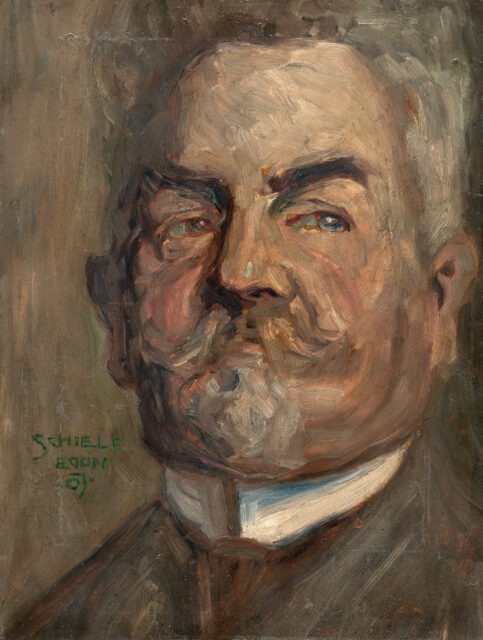Head of a bearded man I (Leopold Czihaczek)
Details
Inscribed on the reverse by Anton Peschka, artist and brother-in-law of Schiele: “Bestätige die Echtheit Wien am 16/3 1921 Ant. Peschka” (authenticity confirmed Vienna on 16/3 1921 Ant. Peschka). Kallir P 21.Literature: Malafarina, Gianfranco. L’Opera di Schiele, Milan 1982, cat. no.28; Nebehay, Christian M., Egon Schiele und die Eisenbahn, Vienna 1995, p. 47; Kallir, Jane, Egon Schiele’s Women, Munich 2012, p. 51, with ill.55; Bauer, Christian, Egon Schiele. Fast ein ganzes Leben, Munich 2015, p. 46, with ill.12.Exhibitions:Egon Schiele: Frühe Werke und Dokumentation, Christian M. Nebehay, Vienna 1968, cat. no.1, with ill. Egon Schiele, The Seibu Museum of Art, Tokyo 1979, cat. no.5, with ill. Egon Schiele, Pinacoteca Capitolina, Rome et. al. 1984-1987, cat. no.1, with ill. Egon Schiele. An Exhibition of 17 Paintings, Serge Sabarsky Gallery, New York 1985, cat. no.3; Egon Schiele. Gustav Klimt, Fondation Pierre Gianadda, Martigny 1986/87; EUROPALIA 87. Österreich. Egon Schiele, Palais des Beaux-Arts, Charleroi 1987, cat. no.3; Egon Schiele. 1890-1918. A Centennial Retrospective, Nassau County Museum of Art, Roslyn 1990 (with label on the back of the frame); Egon Schiele. Frühe Reife. Ewige Kindheit, Historisches Museum der Stadt Vienna, 1990, cat. no.1.16, S. 32, with col. illus. 1; Egon Schiele. 100 Zeichnungen und Aquarelle, Oberösterreichisches Landesmuseum, Linz et. al. 1990-1993, teilw. cat. no.3; Egon Schiele. Acquarelli e dipinti, Palazzo della Permanente, Milan 1991, cat. no.67; Egon Schiele. Gemälde aus amerikanischen Sammlungen, Rupertinum, Salzburg/ Österreichische Galerie/ Oberes Belvedere, Vienna 1991/92; Egon Schiele. Gemälde, Zeichnungen und Aquarelle, Schlots Mainau, 1994, cat. no.1; Egon Schiele, Fondation Pierre Gianadda, Martigny 1995, cat. no.2;Klimt Schiele Kokoschka, Musée des Beaux-Arts de Rouen, 1995, cat. no.120; Neue Galerie Museum, New York 2009 – 2011; Belvedere Museum, Vienna 2011; Neue Galerie Museum, New York 2018/19. Provenance: The artist’s estate, 1918; Otto Nirenstein, Vienna; Maier, Brünn, as of 1930; Christian M. and Ingo Nebehay, Vienna, as of 1968; Ingo Nebehay, Vienna, as of 1969; collection of/estate of Serge Sabarsky, New York, acquired from the aforementioned in around 1970; collection of/Foundation Vally Sabarsky, New York.
Descrizione
• Early work by the then 17-year-old Schiele
• Depicting his uncle and guardian, who Schiele painted numerous times in around 1907
• The young artist masterfully captures the sitter’s critical gaze
The painting shows Leopold Czihaczek (1842-1929), Egon Schiele’s uncle and guardian. Schiele dedicated a total of 15 paintings to his uncle in the period around 1907, and also captured the Czihaczek couple’s flat. After Schiele’s father, Adolf Schiele, died in 1905, his uncle adopted the young artist. He was an important civil servant in the Austro-Hungarian Monarchy. In his portraits of Leopold Czihaczek, Egon Schiele shows the social position associated with his uncle’s status as a civil servant and repeatedly portrays him as a cultivated, intellectual citizen: sitting on a sofa reading, with a cigar in his hand, at the piano, or in evening dress with a top hat. Other depictions are similar to the one offered here: Schiele depicts his stately uncle with a white moustache in (half) profile, as a bust or still image. The present picture is particularly striking for its alert and scrutinising gaze. With his chin slightly raised and his lips slightly drawn in, Leopold Czihaczek is not looking at the viewers but sideways past them, as if he wanted to observe the man behind the easel. It is documented that his uncle had a negative attitude towards Schiele’s aspirations of becoming an artist. Schiele’s application to the Vienna Academy of Fine Arts had been accepted a year before the painting was created, in 1906. He was only 16 years old and was now allowed to study and become an artist. It is quite possible that, for reasons of availability, he had to choose models from his immediate environment at the time. Other artists have also been known to paint whatever and whomever they had at their disposal during their student years, so that close relatives and flatmates take centre stage in their pictures. Schiele’s work, depicting his uncle in an academic style, can be viewed as such a study. Gustav Klimt, with whom Schiele intensified his contact in the year of the painting offered here, also practised his own skills as a young student. The uncle’s expression can be read as one of doubt: he seems unsure about what his young nephew is doing. Schiele was embarking on a career path that his uncle did not approve of, and listening to the advice of his free-spirited mentor Klimt. One can sense this uncertainty creeping into the facial expression of the proud citizen Czihaczek, but his doubt surely vanished after the completion of the present painting and the realisation of Egon Schiele’s early talent.
* Tutte le informazioni includono la commissione a carico dell'acquirente (27%) senza IVA e senza garanzia. Salvo errori.
** Tutte le informazioni più la commissione a carico dell'acquirente e l'IVA e senza garanzia. Salvo errori.
*** Con riserva: L'offerta è stata accettata al di sotto del limite. L'acquisizione dell'opera potrebbe essere ancora possibile nella nostra vendita post-asta.
R = Le opere d'arte regolarmente tassate
N = Opere d'arte soggette a tassazione differenziata e provenienti da un paese non UE
Non è consentita la riproduzione e la distribuzione privata o commerciale di tutte le illustrazioni delle opere esposte nell'archivio della mostra e dell'asta. Tutti i diritti riservati.


